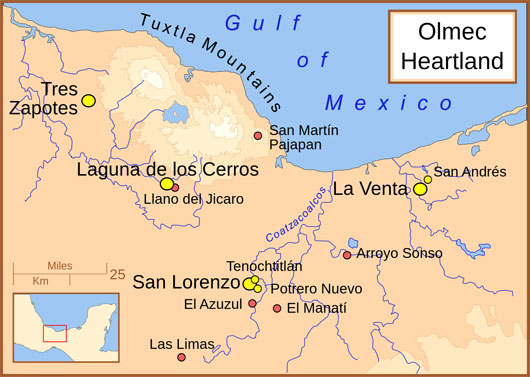Mexico discovered two artifacts dating back 3,000 years
Reporters in Mexico City reported on November 29 by the National Autonomous University of Mexico (UNAM), a group of school archaeologists has discovered two artifacts dating back 3,000 years at the archaeological site of San. Lorenzo Tenochtitlán in Eastern Veracruz state.
According to professor, Dr. Ann Marie Cyphers Tomic, Head of UNAM Archeology Group, two ceramic plates found to be of the Olmeca civilization that existed between 1400 and 200 BC.
Two ceramic plates made from basalt stones with a diameter of up to 61cm.

Archaeological site of San Lorenzo Tenochtitlán in the eastern state of Veracruz.(Photos: Wikipedia)
On the surface of the first disk, the eagle's legs were carved, while the second plate had the shape of the leopard legs, most likely the emblem of the Emperor who carried out the construction of the central Palace of the Olmeca civilization, now part of the archaeological site of San Lorenzo Tecnochtitlán.
Historically, Mexican archaeological science still considers the Olmeca civilization the source of other civilizations in North Central America.
Olmeca's most flourishing period was from 1,150 to 400 BC spanning the vast territory that today includes Central American countries and some southern Mexican states.
Besides the famous and unique buildings such as the Stone Tower, the Olmeca people are also highly appreciated for the level of stone carvings and stone statues.
A famous artifact of this civilization is the statue of God Tlaloc (Water God) currently on display at the entrance to the Mexican National Anthropological Museum in Mexico City.
- Human footprints date back to 25,000 years in Mexico
- Discover 10 ancient tombs dating back more than 3,000 years
- Mexico discovered an ancient burial site dating back to 800 years
- Discovered many thousand-year-old artifacts in the lake
- Mexico discovered 2,000-year-old palace foundation
- Mexico discovered many important archaeological sites
- Mexico found fossil fish dating back 110 million years
- Mexico discovered human skeleton more than 10,000 years
- Detecting ancient artifacts 2,500 years when clearing bombs and mines
- Excavation of the tomb dating back to 3000 years old
- Mexico discovered the Tubar people complex
- Ancient industrial park discovered in Monkey Valley
 Discovered an ancient centipede fossil 99 million years old
Discovered an ancient centipede fossil 99 million years old Discovered bat-like dinosaurs in China
Discovered bat-like dinosaurs in China Discovered a 200-year-old bronze cannon of the coast
Discovered a 200-year-old bronze cannon of the coast Discover 305 million-year-old spider fossils
Discover 305 million-year-old spider fossils